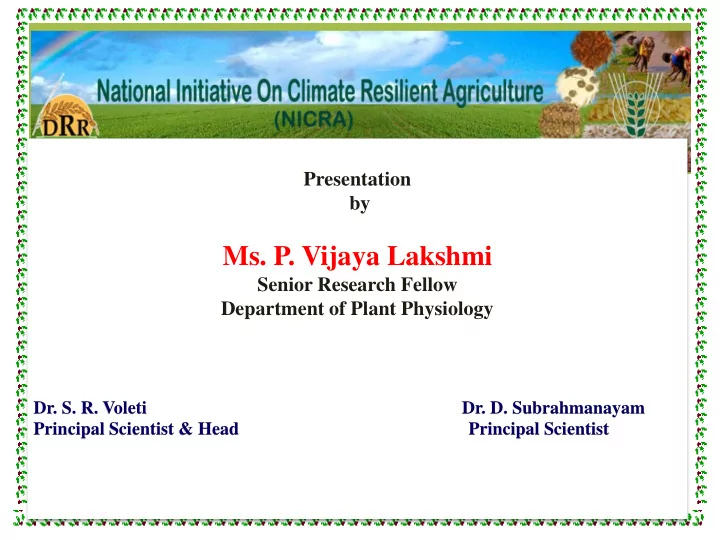

Presentation by Ms. P. Vijaya Lakshmi Senior Research Fellow Department of Plant Physiology Dr. S. R. Voleti Dr. D. Subrahmanayam Principal Scientist & Head Principal Scientist
Screening of Parental lines for Nitrogen Use Efficiency Around 78 Aromatic rice varieties were collected from Plant Breeding department, DRR, Hyderabad Physiological Parameters Yield Parameters Chlorophyll estimation by (SPAD Panicle weight Leaf Thickness (Model 06-664-16, Fisher Scientifics, USA) Panicle Number Leaf area ( Leaf area meter, LI-COR Environmental, USA) Filled grain weight Leaf Temperature ( Infra red thermometer, Made, ,model) Unfilled grain weight Leaf Rolling ( DRR method : in vivo) Total grain weight Dry weight Morphological Parameters Total dry weight & Harvest index Plant height Tillers Effective booting tillers
Genotypes Selected Based on overall physiological & yield traits High Nitrogen Use efficiently rice varieties 1. Basmathi 370 2. Ranbir Basmathi 3. Dehradun Basmati N-0 field at vegetative stage 4. Krishna Joha Low Nitrogen Use efficiently rice varieties 5. Kola Joha 3 N-100 field at vegetative stage 6. Ratnasundari
Breeding and Molecular work The selected genotypes were crossed reciprocally in the year of Kharif 2012 and collected the F1 seed. The parental polymorphism was done by using SSR primers. Selected Polymorphic primers were used for F1 conformation. In Rabi 2014, 4 cross were selected out of 15 crosses. The selected cross of f1 seed material were sown in field condition above said 4 population will be used for mapping. Polymorphism studies between different selected parents
F1 Conformation by using SSR primers P 2 P 1 F 1 P 1 F 1 P 2 F 2 populations of the selected crosses were planted in N-100 and N-0 plots in field, number of F 2 plants in each cross in N-100 and N-0 are listed below. CROSS NAME No of F2's in N-100 No of F2's in N-0 (A1) Basmati 370 X BPT 5204 167 120 (A3) Basmati 370 X IR64 188 200 (A4) Dehradun basmati X BPT 5204 135 160 (A6) Dehradun basmati X IR64 168 112
Biochemical Work The leaf material was collected from selected genotypes at different N levels during different growth stages like vegetative and Reproductive. The collected leaf was grinded with liquid nitrogen and stored at -20 º c. The Glutamine synthetase activity was measured in 120 genotypes at vegetative stage, remaining GOGAT and GDH activity is processing. The quantity measurement of photorespiration was standardised and done in fifty field samples at vegetative stage and also standardised nitroprusside method for N estimation. Below Listed Parameters were Measured in High and Low Nue genotypes GS, NR Chlorophyll Florescence Photosynthetic Pigment Photosynthesis SLA , SLW, Thickness and SPAD
Mean of High and Low NUE genotypes at Different N levels
Nitrogen Use Efficiencies AE= Agronomic Efficiency (Kg/Kg) PE= Physiological Efficiency APE= Agro Physiological Efficiency ARE=Apparent Recovery Efficiency RE= Recovery Efficiency Agronomic efficiency Physiological efficiency
Agro physiological efficiency Apparent recovery Efficiency Utilization Efficiency
Salient Findings Publications: P. Vijayalakshmi • T. Vishnu Kiran • Y. Venkateswara Rao • B. Srikanth • I. Subhakara Rao • B. Sailaja • K. Surekha • P. Raghuveer Rao • D. Subrahmanyam • C. N. Neeraja • S. R. Voleti “The Physiological approaches for increasing nitrogen use efficiency in rice crop” and was published in Indian journal of Plant Physiology. Ind J Plant Physiol. (July – September 2013) 18(3):208 – 222. T. Vishnu Kiran, N. Sravan Raju, P. Senguttuvel , P. Vijayalakshmi , Y. Venkateswara Rao, K. Surekha, C.N. Neeraja, and S.R. Voleti. "Screening of Hybrids and parental lines for association of physiological traits to identify heat tolerant and nitrogen use efficient genotypes in rice (Oryza sativa L)" was submitted for proceedings of 6 th international hybrid rice symposium. (In press). P. Vijayalakshmi • T. Vishnu Kiran • Y. Venkateswara Rao • B. Srikanth • I. Subhakara Rao • P. Raghuveer Rao • D. Subrahmanyam • C. N. Neeraja • S. R. Voleti “Screening of aromatic rice for NUE and influence of Different Nitrogen levels on scavenging enzyme activity in rice ( Oryza sativa L.), was submitted to Indian journal of Plant Physiology. (In Communicated). A written a part of biochemical work in Bulletin entitled on Nitrogen Use Efficiency in irrigated rice for climate change – a case study .
Salient Findings Abstracts and Poster Presentation: C.N. Neeraja, S.R. Voleti, K. Surekha, D. Subrahmanyam, I. Subhakararao, B. Srikanth, P. Vijayalakshmi, N. Sailaja, P. Revathi, B.C. Viraktamath (India). P0024 Identification of Genotypes, Genomic Regions And Genes for Nitrogen Use Efficiency in Rice. Presented at 7 th International Rice Genetics Symposium. 5 - 8 November 2013 Dusit Thani Hotel, Manila, Philippines Training programs: I was actively participated in one day work shop entitled on Nitrogen use efficiency in Rice at Directorate of Rice Research, Hyderabad. (23 rd September). I was attended training program entitled Awareness – cum-training programme on protection of plant varieties and farmers Rights Act 2001 and its Provisions at Directorate of Rice Research, Hyderabad (21 st December 2013).
Future plan of work Leaf collection from F 2 populations and DNA isolations. Phenotypic observation will be recorded in population and parents, as mentioned below Heading date (50% flowering), Plant height at maturity, no of tillers, no of productive tillers, SPAD of flag leaf, Yield parameters, Biomass, N content in grains.
Acknowledgement My sincere thanks to Dr. B. C. Viraktamath, Project Director, DRR for overall supervision and also gratitude to Dr. S. R. Voleti for his great encouragement and valuable guidance. Acknowledge the NICRA (ICAR) Delhi, financial support for doing an innovative research work.
Recommend
More recommend